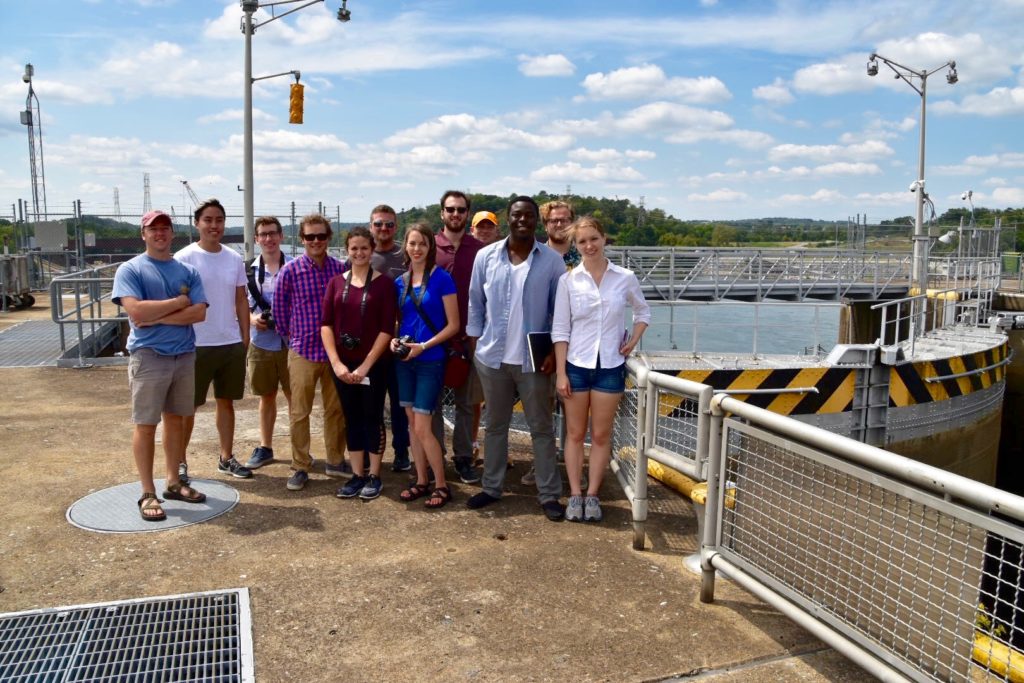September 22, 2016 Students Trek 1,157-mile Tour of Tennessee River to Design Solutions
Four states, five days, 1,157 miles and all the catfish they could eat…The University of Tennessee, Knoxville College of Architecture and Design’s tour of the Tennessee River is completed.
But work has just begun.

Sept. 7-11, a dozen Architecture and Landscape Architecture students in the Governor’s Chair Tennessee River Studio, led by Asst. Professor Brad Collett, followed the Tennessee River as it winds its way through Tennessee, Alabama, Mississippi and Kentucky to understand the influences and impacts on the river system.
The Tennessee River Studio, the second studio in the UT-ORNL Governor’s Chair for High Performance Energy Practices in Urban Environments at the College of Architecture and Design, is investigating the 21st Century challenges facing the Tennessee River and its 40,000-square mile watershed and how those who live near, work on and engage with the river can understand and mitigate challenges and recognize and take advantage of the river’s untapped potential.
Beginning in August, the undergraduate and graduate students began building a Tennessee River atlas that captures the many communities, landscapes and systems of the river’s watershed. The following month, the tour gave them the opportunity to see how these features interact with the health of the river and meet face-to-face with people who rely on and are impacted by the river system.
“It is unmistakable that the Tennessee River system and its watershed are the life-blood of the region,” said Kenny Townsend, third-year student in the college’s Master of Landscape Architecture program. “The river system, much like any organic circulatory system, is a mode of transport distributing sustenance and removing waste. The pulse and overall health can be measured by its water quality. In the case of the Tennessee River system, we found that it exhibits its fragility.”

With atlas in hand, the students and faculty embarked upon the tour from the most logical of places: The confluence of the French Broad and Holston rivers where the Tennessee River actually begins. Here, they met with UT Institute of Agriculture representatives, who described how their work relies on the water.
They wound their way through the region and questioned river system engineers about challenges
with human interaction with the river. They stood alongside farmers and learned how the river often dictates the success of the crop. The group met with city planners and ecologists to hear about urban development and water quality and discussed tourism, recreation, industry, pollution, energy production and more with business and community leaders and representatives of non-profit organizations and governmental agencies.
Download 2016_River-Tour-Itinerary
“The insights gained from those with whom we met, the conditions we observed and the experiences we shared on the river tour combine to provide a rare and unique perspective for us to begin thinking about the Tennessee River of the 21st Century,” said Collett. “Beyond a sense of enthusiasm about the relevance and importance of our short-term academic objectives, we also return with a level of excited confidence that the relationships we have only begun to cultivate through the River Tour will be of equal, if not greater value to the future of the Tennessee River system and its watershed.”

This intensive five-day journey was not without its moments of fun. Inspired by river culture and those they met along the way, the intrepid group began affectionately referring to themselves as River Rats, Junior Rangers and Aquatots. They found iconic mom-and-pop restaurants and enjoyed the best barbecue and catfish the South can dish out.
Certainly lighthearted, these experiences served to further instill into the students life lived along the river, as they now are tasked to assimilate the information they gathered into important—almost urgent—design solutions to address some of the river’s challenges.
Knowledge and perspective gained during the tour are now informing the students’ semester projects, which will address and provide some possible solutions to some of the 21st Century challenges identified by the students during the tour. Their proposals will be reviewed by river stakeholders and peer educators on Nov. 18 in the college’s Fab Lab located at 525 North Gay Street. Plans to share the work with members of the Tennessee River community are currently under development.
Fifth-year Architecture student, Journey Roth, was influenced by the interactions with people along the tour, which, she says, will become part of her design solution. “Each individual has a deep understanding of the river, which they have gained from personal experiences. This gives them a unique view,” she said. “The collaborative approach of this project is the only way we can grow to understand the river deeply and make any lasting changes. While knowing the annual rainfall, for example, is absolutely important, understanding people’s needs and the needs of the river is key in being able to move forward with design.”

In addition to interacting with people along the river, the students’ research also included water quality sampling, photo-essays and individual reflections. This information has enriched their understanding of the river system, is enhancing their design solutions and will continue to inform future River Studio initiatives.
Read about the launch of the Tennessee River Project.
Follow the students’ journey and learn more about their insights, comprehensive report and final design proposals on Twitter, Instagram and Facebook: @UTRiverStudio and at archdesign.utk.edu.
Started in 2014, the Governor’s Chair for High Performance Energy Practices in Urban Environments is a five-year, $2.5 million public-private partnership of the University of Tennessee College of Architecture and Design; Skidmore, Owings and Merrill; and Oak Ridge National Laboratory. The Governor’s Chair is a catalyst for change that seeks to optimize the relationship between energy and urbanism. Using the unique collaboration of science, design and academia, the Governor’s Chair partners pursue environmentally responsible design, emerging clean energy technologies for buildings and communities, sustainable urban planning and a merging of urbanism and natural systems to open new vistas of research and exploration.
Tennessee River Tour
[showcase slug=”tennessee-river-tour”]


